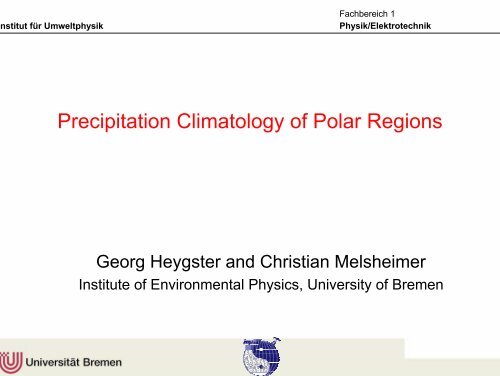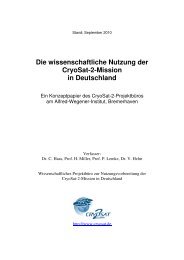Precipitation Climatology of Polar Regions
Precipitation Climatology of Polar Regions
Precipitation Climatology of Polar Regions
You also want an ePaper? Increase the reach of your titles
YUMPU automatically turns print PDFs into web optimized ePapers that Google loves.
nstitut für Umweltphysik<br />
Fachbereich 1<br />
Physik/Elektrotechnik<br />
<strong>Precipitation</strong> <strong>Climatology</strong> <strong>of</strong> <strong>Polar</strong> <strong>Regions</strong><br />
Georg Heygster and Christian Melsheimer<br />
Institute <strong>of</strong> Environmental Physics, University <strong>of</strong> Bremen
Overview<br />
<strong>Precipitation</strong> <strong>Climatology</strong> in <strong>Polar</strong> <strong>Regions</strong><br />
• A. Ice sheet<br />
• B. Sea Ice
A. Ice Sheets<br />
• <strong>Precipitation</strong> one <strong>of</strong> the largest uncertainties in the mass budget <strong>of</strong> ice<br />
sheets<br />
• Change in height determined by<br />
– <strong>Precipitation</strong> P<br />
– Melting S<br />
– Displacement<br />
• Determine daily maps <strong>of</strong> P from<br />
– atmospheric model and<br />
– daily water vapor from water vapor sounder AMSU-B<br />
– Procedure developed by Miao et al. (2001)
Total Water Vapour (TWV) from humidity sounders<br />
• SSM/T2 and AMSU-B: 5 channels 183±1, ±3, ±7, 150, 89 GHz<br />
• expressions ln (T1-T2)/(T2-T3) ~ TWV<br />
(Miao et al., 2001)
A. Ice Sheets (cnt‘d)<br />
• 3 ways to merge remote sensing and model data<br />
– Assimilation (NWP: IOMASA)<br />
– Nudging<br />
– Normalize model WV pr<strong>of</strong>iles <strong>of</strong> model with observed TWV<br />
• Determine precipitation climatology and patterns <strong>of</strong> ice sheets<br />
• Combine with<br />
– land ice models and<br />
– snow drift models<br />
• Cross-check with thickness balance from CRYOSAT<br />
• GLIMS (Global Land Ice Measurements from Space) contribution
B. Sea Ice<br />
• Similarly: Develop precipitation climatology and distribution over sea<br />
ice<br />
• Include also LWP from SSM/I and AMSR<br />
• Method proposed by Miao et al. (2000) using<br />
T ( 1) ( 1)<br />
( 1, 2) ln<br />
v f −Th<br />
f<br />
R f f =<br />
• R-factor<br />
Tv( f2) −Th(<br />
f2)
<strong>Regions</strong> <strong>of</strong> Interest<br />
July 18, 2002,<br />
ASI algorithm<br />
(Kaleschke et al., 2001)<br />
• a: Sea Ice<br />
• b: Open Water
Applications: Sea Ice (region a)<br />
• Cloud System <strong>of</strong> July 18, 2002<br />
• CLW typical feature over meteorological front<br />
• PWV low on rear side <strong>of</strong> low pressure system
B. Sea Ice (cont‘d)<br />
• Validation <strong>of</strong> CLW difficult, <strong>Polar</strong>stern campaign with microwave<br />
radiometer?<br />
• Assimilate precipitation into sea ice model<br />
• Goal: Evaluate meteoric part <strong>of</strong> sea ice
Conclusions<br />
• Combine atmospheric remote sensing data with atmospheric models<br />
• Ice sheets:<br />
– Cross-validate ice thickness,<br />
– establish budget <strong>of</strong> components<br />
• Sea ice:<br />
– Quantify meteoric part <strong>of</strong> sea ice
Retrieval Method: R factor<br />
• Radiation received at sensor (Grody, 1986)<br />
( ) = − ⎡ − ( ) ⎤ − ( )<br />
with T brightness temperature<br />
p ( f )<br />
p polarization h, v<br />
ϑ<br />
R factor<br />
[ ]<br />
Tp f Ts Ts⎣1 ε p f ⎦ exp 2τ f secϑ<br />
f<br />
T S<br />
τ<br />
( f )<br />
frequency<br />
surface temperature<br />
nadir opacity<br />
zenith angle at surface<br />
T ( 1) ( 1)<br />
( 1, 2) ln<br />
v f −Th<br />
f<br />
R f f =<br />
T ( f ) −T<br />
( f )<br />
v<br />
2 h 2
Retrieval Method: R factor (2)<br />
• R factor<br />
T ( 1) ( 1)<br />
( 1, 2) ln<br />
v f −Th<br />
f<br />
R f f =<br />
T ( f ) −T ( f )<br />
v<br />
2 h 2<br />
[ ] (<br />
( ) β ( ) α ( )<br />
= R f , f + f , f ⋅ L+ f , f ⋅ W + R f , f<br />
S 1 2 1 2 WL 1 2 d 1<br />
( )<br />
with RS<br />
f1,<br />
f2<br />
surface contribution<br />
L<br />
liquid water path<br />
W<br />
precipitable water path<br />
Rd<br />
( f1,<br />
f2)<br />
dry air contribution<br />
β ( f2, f1) = 2secθ ⋅∆κL<br />
∆κW<br />
( f1,<br />
f2)<br />
αWL<br />
( f1,<br />
f2)<br />
= ∆ κ f , f<br />
∆ κ L ( f 1,<br />
f 2)<br />
( , )<br />
∆κ W f f<br />
1 2<br />
L<br />
( )<br />
1 2<br />
liquid water mass absorption coefficient difference<br />
water vapor mass absorption coefficient difference
Retrieval method: frequency combinations<br />
Recall:<br />
( α )<br />
R= R + β L+ W + R<br />
S WL d<br />
α<br />
β = θ ⋅∆κ<br />
WL<br />
( f2, f1) 2sec L<br />
( f , f )<br />
1 2<br />
∆κ<br />
= ∆ κ<br />
W<br />
L<br />
( f1,<br />
f2)<br />
( f , f )<br />
1 2<br />
esired:<br />
– α small: large CLW contribution<br />
– β large: small surface contribution<br />
– Rs: small surface contribution<br />
elect 2 frequency combinations: 2 eqs for 2 unkowns L, W.
SSM/I vs. AMSR characteristics<br />
Frequency [GHz]<br />
Resolution [km]<br />
SSM/I AMSR(-E) SSM/I AMSR(-E)<br />
- 6.9 - 71x41<br />
- 10.7 - 46x25<br />
19 18.7 69x43 25x15<br />
22 V 23.8 50x50 23x14<br />
37 36.5 37x29 14x8<br />
85 89 15x13 6x4<br />
- 50.3 V - 12x6<br />
- 52.8 V - 12x6<br />
All channels H + V polarisation if not indicated otherwise.<br />
Channels near 50 GHz on AMSR only.
Applications: Open Ocean (region b)<br />
• compare to results <strong>of</strong> Wentz <strong>of</strong> July 17, 2002<br />
• exclude precipitating cases (Tb (36V) > 240K)<br />
• PWV: correlation all data r = 0.98, below 35 kg/m2 stronger<br />
• CLW: non-linear relation<br />
• deviations potentially caused by scattering cloud ice
Conclusions<br />
Retrieval <strong>of</strong> CLW and PWV over sea ice and open ocean<br />
• appears feasible<br />
• more knowledge about surface influence required<br />
• concept <strong>of</strong> R factor may be noise sensitive, other approaches also<br />
considered





